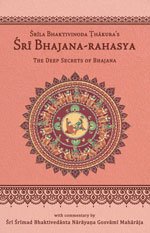Bhajana-Rahasya
by Srila Bhaktivinoda Thakura Mahasaya | 2010 | 123,965 words
The Bhajana-rahasya Text 5, English translation, including commentary (vritti). The Bhajana-rahasya is a compilation of verses describing the mercy of the eight pairs of names (Yugala-nama) of the Maha-mantra. This is text 5 belonging to the chapter “Pancama-yama-sadhana (Aparahna-kaliya-bhajana–krishna-asakti)” representing from three-and-a-half praharas of the day until dusk: approximately 3.30 p.m.–6.00 p.m.
Text 5
The nine types of bhakti-sādhana are described in Śrīmad-Bhāgavatam (7.5.23–24):
श्रवणं कीर्तनं विष्णोः स्मरणं पाद-सेवनम् अर्चनं वन्दनं दास्यं सख्यम् आत्म-निवेदनम्
इति पुंसार्पिता विष्णौ भक्तिश् चेन् नव-लक्षणा क्रियेत भगवत्य् अद्धा तन् मन्ये’धीतम् उत्तमम्śravaṇaṃ kīrtanaṃ viṣṇoḥ smaraṇaṃ pāda-sevanam arcanaṃ vandanaṃ dāsyaṃ sakhyam ātma-nivedanam
iti puṃsārpitā viṣṇau bhaktiś cen nava-lakṣaṇā kriyeta bhagavaty addhā tan manye’dhītam uttamamA person is said to have perfectly studied the scriptures if he is completely surrendered to Bhagavān Śrī Viṣṇu, if he is free from karma, jñāna, yoga and other obstructions, and if he is engaged in the nine kinds of bhakti : hearing topics related to the Supreme Lord (śravaṇam);chanting His name (kīrtanam); remembering His name, form, qualities and pastimes (smaraṇam); serving His lotus feet (pāda-sevanam);performing deity worship (arcanam); offering prayers (vandanam);becoming His servant (dāsyam); becoming His friend (sakhyam);and offering one’s very self (ātma-nivedanam). Only such a person’s study of the scriptures is successful.
श्रवण-कीर्तन-आदि-भक्तिर प्रकार
चिद्-घन-आनन्द कृष्णे साक्षात् याङ्हारśravaṇa-kīrtana-ādi-bhaktira prakāra
cid-ghana-ānanda kṛṣṇe sākṣāt yāṅhāraसर्व-शास्त्र-तत्त्व बुझि’ क्रिया-पर तिनि
सर्वार्थ-सिद्धिते तिङ्ह विज्ञ-शिरोमणिsarva-śāstra-tattva bujhi’ kriyā-para tini
sarvārtha-siddhite tiṅha vijña-śiromaṇi
Commentary: Bhajana-rahasya-vṛtti:
The nine kinds of devotion, navadhābhakti, comprise svarūpa-siddha-bhakti, unalloyed devotion. Other types of devotional practices fall into the categories of saṅga-siddhabhakti, āropa-siddha-bhakti and so forth. It is essential that one completely surrender to Śrī Bhagavān, for one cannot enter svarūpasiddha-bhakti without surrender. This is the import of the phrase iti puṃsārpitā viṣṇau in this Text. According to Śrīla Sanātana Gosvāmī, the word puṃsā here indicates the māyā-baddha-jīva, conditioned living entity, who is attached to sense enjoyment. The words bhagavaty addhā refer to the instruction to perform service to the Supreme Lord that is stimulated by devotion that flows like a continuous stream of oil.
